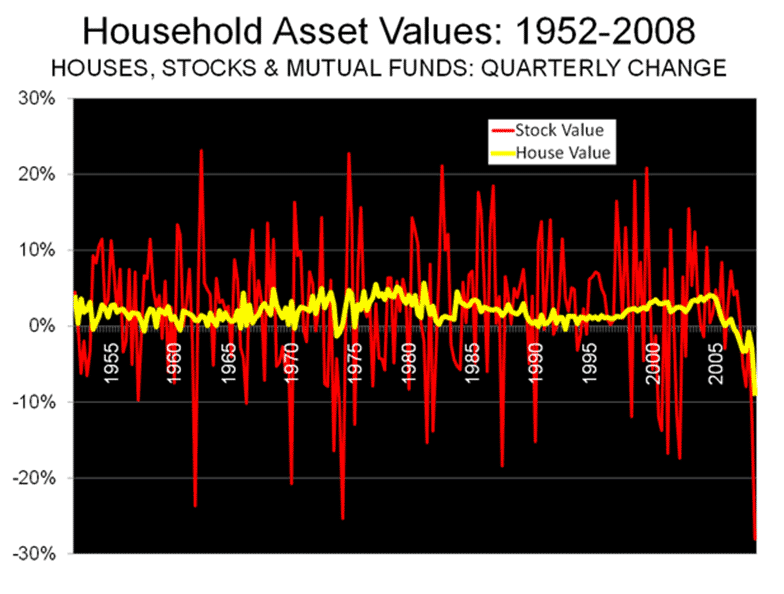It is common knowledge that the world financial crisis began in the United States. In short, the crisis would not have occurred if the US had not been “asleep at the switch” as bankers gave money to any with a pulse and if it had not allowed major markets to regulate their house prices to unheard of heights through overly strict land use regulations (called urban consolidation in Australia and smart growth in America).
Just as the US started it all, its recovery will also be important to the world economy. In that light, it is useful to review the present economic downturn in comparison with others in recent decades.
It is frequently claimed that the crash of 2008 is the worst economic downturn since the Great Depression. There is plenty of reason to accept this characterisation, though we clearly are not suffering the widespread hardship of the Depression era. Looking principally at historical household wealth data from the Federal Reserve Board’s Flow of Funds Accounts of the United States, summarised in our Value of Household Residences, Stocks & Mutual Funds: 1952-2008, we can conclude it’s pretty bad, but nothing yet like the early 1930s.
Advertisement
But this Panic of 2008 is no picnic. And in some key areas, notably housing, it could become even worse than what was experienced in the Great Depression.
Housing
It all started with the housing bubble that saw prices in some markets rise to unheard of levels, principally in California, Florida, Phoenix, Las Vegas and the Washington, DC area. Mortgage lenders were unable to withstand the intensity of losses that resulted from interest rate resets and declining prices. This precipitated the Lehman Brothers bankruptcy on Meltdown Monday (September 15, 2008) and a far broader economic crisis since that time.
Before the housing bubble, housing had been a stable store of wealth (equity or savings) for Americans, just as it has been in Australia. According to government data, the value of the US owned housing stock increased in every year since 1935. The bursting of the housing bubble, however, brought declines in both 2007 and 2008, the longest period of housing value decline since between 1929 and 1933. The value of the housing stock was down 20 per cent from its peak at the end of 2008. In some markets the losses amounted to more than double this amount. By comparison, the 1929 to 1933 house value decline was 27 per cent. However, only one Great Depression year (1932) had a larger single-year decrease than 2008.
Indeed, between 1952 and 2006, the value of the housing stock never declined for more than a three month period. The bubble changed all that. The value of the housing stock has now fallen eight straight quarters. An investment that has been safe for most middle class Americans - the house in the suburbs - suddenly experienced the price volatility usually associated with the stock market, as is indicated in the chart below.

The resulting losses have been substantial. By the end of 2008, the value of the housing stock had fallen $4.5 trillion. In Phase I of the housing downturn, before Meltdown Monday, the largest losses were concentrated in the markets with the biggest “bubbles”, (PDF 21KB). But since that time the market has entered a Phase II decline, while a more general decline has characterised housing markets around the country in the fourth quarter of 2008. The decline continues.
Advertisement
California, the largest of all the states, has been particularly hard hit. New data for both the San Francisco and Los Angeles areas show price drops of about 10 per cent in January, 2009 alone, as prices fall like the value of a tin-pot dictatorship’s currency. This decline, it should be noted, has spread from the outer ring of these areas - places like the much maligned inland California markets - into the formerly more stable, and established, areas closer to the larger urban cores, which some naively imagined would be safe from such declines.
Sadly, there may well be some time before house price stability can be achieved. To restore the historic relationship between house prices and household incomes to a Median Multiple (median house price divided by median household income) of 3.0 would require another $3 trillion in losses, equating to a more than 15 per cent additional loss. Losses are likely to be greater, however, not only in the “ground zero” markets of California and Florida but also other hugely over-valued markets, such as Portland, Seattle, New York and Boston. Of course, these are not normal times, and an intransigent economic downturn could lead to even lower house values than the historical norm would suggest.
Stocks and mutual funds
As noted above, stocks and mutual funds have been inherently more volatile than housing values. According to Federal Reserve data, the value of these holdings fell 24 per cent during the year ended September 30. During the intervening “panic” months, declines have accelerated. Based upon later data from the World Federation of Exchanges, we estimate that the value declined sharply after September 15 (PDF 96KB), and at December 31 stood at 45 per cent below the peak.
This article is adapted from one previously published in newgeography.com.